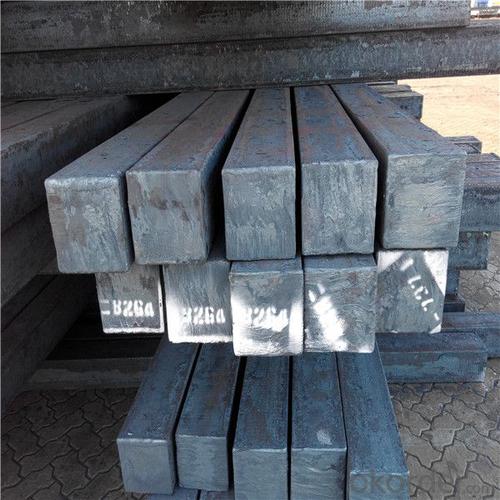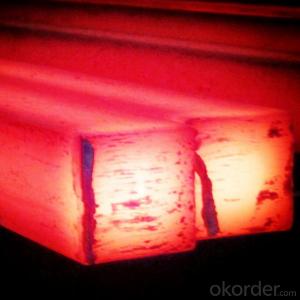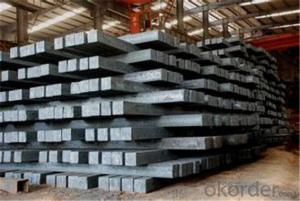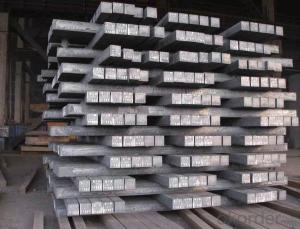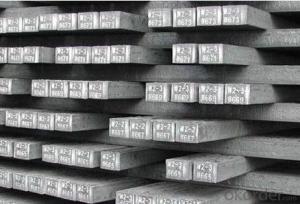China newly Square Steel Billets Size 60-150mm 3sp/ 5sp for sale
- Loading Port:
- Tianjin
- Payment Terms:
- TT OR LC
- Min Order Qty:
- 1000 m.t.
- Supply Capability:
- 15597 m.t./month
OKorder Service Pledge
OKorder Financial Service
You Might Also Like
Billets, or ingots (as they sometimes referred to), are not of practical use until they have been formed into
more functional shapes and sizes. While they have already been put in the furnace, they still require a series
of shaping and molding procedures such as hot and cold working, milling and cutting before they are sold in
hardware stores, or used for different applications. The unformed billets, however, can be used in striking
currency such as coins and as reserves, similar to gold bars.
The billet is mainly divided into two kinds from the shape:
Slab: cross section width and height of the ratio of the larger, mainly used for rolling plate.
Qaulity:own factory, stable quality
Tolerance: Strictly according to the G/B and JIS standard
Delivery time: within 45 days after receiving the L/C or advanced T/T payment.
Price term: FOB/CIF/ CFR according to clients requirements
Payment terms: 100%Irrevercable L/C at sight or T/T
Gade:
Standard | C(%) | Mn(%) | S(%) | P(%) | Si(%) |
Q195 | ≤0.12 | ≤0.50 | ≤0.040 | ≤0.035 | ≤0.30 |
Q235 | ≤0.20 | ≤1.40 | ≤0.045 | ≤0.045 | ≤0.35 |
Q275 | ≤0.22 | ≤1.50 | ≤0.045 | ≤0.045 | ≤0.35 |
20MnSi | 0.17-0.25 | 1.2-1.6 | ≤ 0.050 | ≤ 0.050 | 0.40-0.80 |
3SP | 0.14-0.22 | 0.40-0.85 | ≤ 0.050 | ≤ 0.040 | 0.05-0.15 |
5SP | 0.28-0.37 | 0.50-1.00 | ≤ 0.050 | ≤ 0.040 | 0.15-0.30 |
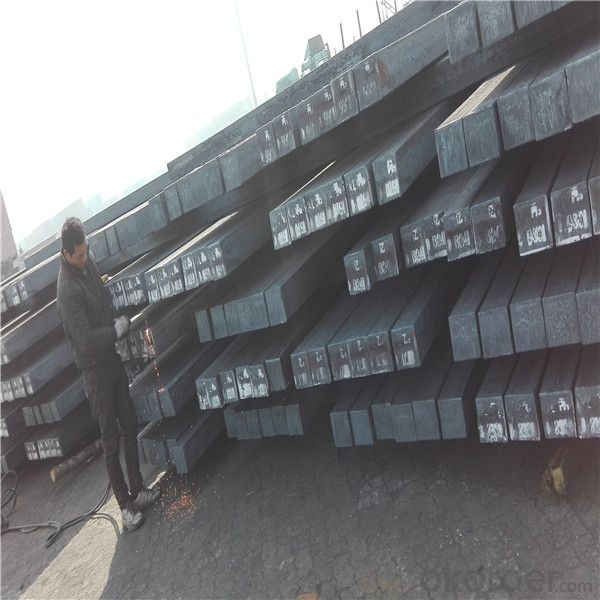
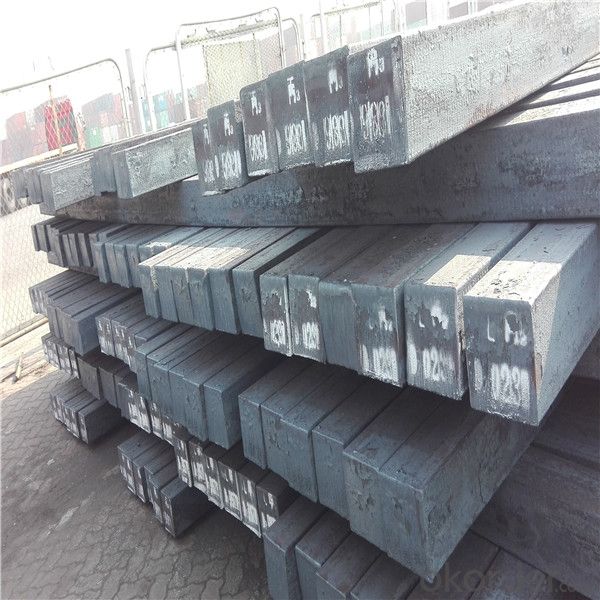

Our service :
We have a plant and professional team to provide our best service, from the start of production until the
loading into the vessel, we have a complete quality follow up procedure, to assure our products arrives to the customer with satisfaction. Welcome new and old customers
to contact us for future business relationships! We will give you a surpise price.
Packing :
Within 30 days
1.Standard export package
2.In bundles with steel strips
3.As the requirements of the customers
FAQ:
Q: What is payment terms?
A: FOB 30% T/T IN ADVANCE AS DEPOSIT AND 70% T/T BEFORE SHIPMENT
CIF and CFR 30% T/T IN ADVANCE AS DEPOSIT AND 70% T/T AS THE COPY OF B/L OR L/C AT SIGHT
Q:How to guarantee the quality of the products?
A:We have established the international advanced quality management system,every link from raw material
to final product we have strict quality test;We resolutely put an end to unqualified products flowing into the market.
At the same time, we will provide necessary follow-up service assurance.
Q:How long can we receive the product after purchase?
A :In the purchase of product within three working days, We will arrange the factory delivery as soon as possible.
The pecific time of receiving is related to the state and position of customers.
- Q: What are the different types of forging processes used for shaping steel billets?
- There are several different types of forging processes that are commonly used for shaping steel billets. These processes include open die forging, closed die forging, and ring rolling. Open die forging is a process in which the steel billet is placed between two flat dies and compressed to shape it. This process is commonly used for larger and simpler shapes, as the steel is not completely enclosed by the dies, allowing for more flexibility in the final shape. Closed die forging, also known as impression die forging, involves the use of specially designed dies that contain cavities in the shape of the desired final product. The steel billet is placed between these dies and compressed, causing the metal to flow and take on the shape of the cavities. This process is commonly used for more complex shapes and allows for greater precision and control over the final product. Ring rolling is a forging process used specifically for shaping steel billets into rings. The billet is placed on a mandrel, and a series of rollers apply pressure to the billet, causing it to deform and take on the shape of a ring. This process is commonly used in the production of seamless rolled rings, which are widely used in industries such as aerospace, oil and gas, and power generation. Overall, these different types of forging processes offer various advantages and are chosen based on the complexity of the desired shape, the required precision, and the specific requirements of the end application.
- Q: What are the common defects in steel billets during hot rolling?
- Some common defects in steel billets during hot rolling include surface cracks, internal cracks, surface scales, segregation, and surface defects such as pits, scars, and scratches. These defects can affect the quality and integrity of the final product and may require further processing or rejection of the billets.
- Q: What are the advantages of using steel billets in the oil and gas industry?
- There are several advantages of using steel billets in the oil and gas industry. 1. Strength and Durability: Steel billets are known for their high strength and durability. They can withstand extreme temperatures, pressures, and corrosive environments, making them suitable for use in the oil and gas industry where demanding conditions are common. 2. Resistance to Corrosion: Steel billets are often made from corrosion-resistant alloys or treated with protective coatings to enhance their resistance to corrosion. This is crucial in the oil and gas industry, as it involves the handling of various corrosive substances that can degrade equipment and infrastructure over time. By using steel billets, companies can ensure their equipment lasts longer and operates efficiently. 3. Versatility: Steel billets can be easily shaped and formed into various components, such as pipes, valves, and fittings, making them highly versatile. This allows for customization and adaptability to specific oil and gas projects, enabling companies to meet the unique requirements of different operations. 4. Safety: The oil and gas industry requires materials that can withstand high-pressure environments and potentially hazardous conditions. Steel billets offer excellent safety properties due to their high strength and resistance to extreme conditions. They are less likely to fail or rupture compared to other materials, reducing the risk of accidents and ensuring the safety of personnel and assets. 5. Cost-effectiveness: While steel billets may have higher upfront costs compared to other materials, their durability and resistance to corrosion reduce the need for frequent replacements or repairs. This leads to long-term cost savings for oil and gas companies. Moreover, steel is a widely available material, making it cost-effective to source and produce steel billets. 6. Environmental Sustainability: Steel is a highly recyclable material, and steel billets can be recycled and reused multiple times without losing their properties. This promotes environmental sustainability by reducing waste and conserving resources in the oil and gas industry. In conclusion, the advantages of using steel billets in the oil and gas industry include their strength, durability, resistance to corrosion, versatility, safety, cost-effectiveness, and environmental sustainability. These properties make steel billets a preferred choice for various applications in the industry, contributing to efficient and reliable operations.
- Q: What are the different types of steel billet rolling mill automation systems?
- The industry commonly utilizes various automation systems for steel billet rolling mills, aimed at enhancing efficiency, accuracy, and overall productivity. Here are some frequently employed automation systems: 1. Level 1 Automation: This constitutes the fundamental level of automation, encompassing basic control and monitoring functions. It typically employs programmable logic controllers (PLCs) to regulate and observe key aspects like speed, temperature, and pressure. While it provides essential functionality, manual intervention may be necessary for certain tasks. 2. Level 2 Automation: This level surpasses the basic control and monitoring functions of level 1. It incorporates advanced process control algorithms and models to optimize mill operations. Level 2 automation systems can automatically fine-tune mill parameters, including roll gap, roll speed, and cooling water flow, to achieve desired product specifications. Additionally, they offer real-time process monitoring and data analysis capabilities. 3. Level 3 Automation: This level concentrates on integrating the rolling mill with other plant systems, such as material handling and quality control. It encompasses features such as automatic scheduling, inventory management, and seamless data exchange between systems. Level 3 automation systems facilitate better coordination and synchronization of the entire production process, leading to increased efficiency and reduced downtime. 4. Artificial Intelligence (AI) and Machine Learning: Advanced automation systems harness AI and machine learning algorithms to continually learn from data collected during rolling mill operations. These systems have the ability to predict equipment failures, optimize production parameters, and even propose process improvements. AI and machine learning-based automation systems enable proactive maintenance, improved decision-making, and enhanced overall productivity. 5. Robotics and Robotics-assisted Automation: Some steel billet rolling mills employ robots for tasks such as loading and unloading, quality inspection, and maintenance. Robotic automation systems offer precision, speed, and repeatability, thereby reducing the reliance on manual labor and enhancing safety. These systems can be integrated with other automation systems to create a fully automated and efficient rolling mill operation. In summary, the various types of steel billet rolling mill automation systems provide different levels of functionality and sophistication. The choice of automation system depends on the mill's specific requirements, the desired level of automation, and the available budget.
- Q: What are the different methods of steel billet surface treatment?
- There are several methods of steel billet surface treatment that are commonly used in the industry. These methods aim to enhance the surface properties of the steel billets, such as improving corrosion resistance, increasing hardness, and improving aesthetics. Some of the most common methods of steel billet surface treatment are: 1. Pickling and Passivation: This process involves the removal of impurities and oxide layers from the steel surface using acid solutions. After pickling, the steel is passivated to create a protective layer that prevents future corrosion. 2. Shot Blasting: Shot blasting is a mechanical surface treatment method that involves the use of high-speed steel shots or grits to bombard the surface of the billets. This process removes scale, rust, and other contaminants, resulting in a clean and uniform surface. 3. Hot-Dip Galvanizing: In this process, the steel billets are immersed in a bath of molten zinc, which forms a protective coating on the surface. This method provides excellent corrosion protection, making it suitable for outdoor applications. 4. Electroplating: Electroplating involves the deposition of a thin layer of metal, such as chrome or nickel, onto the steel surface using an electric current. This method improves the appearance of the steel, enhances corrosion resistance, and can also provide better wear resistance. 5. Powder Coating: Powder coating is a popular method of surface treatment, especially for aesthetic purposes. It involves applying a dry powder onto the steel surface and then curing it through heat, resulting in a durable and attractive finish. 6. Painting: Painting is another common method used for surface treatment. The steel surface is first cleaned and primed before applying a suitable paint system. This method not only enhances the appearance but also provides protection against corrosion and environmental factors. 7. Nitriding: Nitriding is a heat treatment process that involves the diffusion of nitrogen into the steel surface. This method improves the hardness, wear resistance, and fatigue strength of the billets. These are just a few of the various methods of steel billet surface treatment available. The choice of method depends on the specific requirements of the application, desired properties, and budget considerations.
- Q: Are steel billets recyclable?
- Yes, steel billets are recyclable. Steel is one of the most recycled materials in the world, and the process of recycling steel billets is well-established and highly efficient. When steel billets reach the end of their useful life, they can be melted down and reused to produce new steel products. This recycling process helps to conserve natural resources, reduce energy consumption, and minimize environmental impact. Additionally, recycling steel billets also helps to reduce the amount of waste sent to landfills and contributes to the circular economy by promoting the sustainable use of resources.
- Q: How are steel billets used in the manufacturing of valves and pumps?
- Valves and pumps require steel billets, which are necessary raw materials in their manufacturing process. These billets are cast into specific shapes, typically squares or rectangles, and serve as the foundation for producing valves and pumps. To make valves, steel billets are first heated and then forged or rolled into the desired shape. The billets undergo various processes like cutting, drilling, and machining to create different valve components, including the body, bonnet, disc, stem, and seat. These components are then assembled to form the valve, which controls the flow of fluids or gases in a system. Similarly, in pump manufacturing, steel billets are heated and shaped to create essential parts such as impellers, casings, shafts, and housings. These parts are then assembled to construct a pump, responsible for transferring fluids or gases from one location to another. The use of steel billets in valve and pump manufacturing is crucial due to steel's inherent properties. Steel is highly valued for its strength, durability, and resistance to corrosion, making it ideal for applications in industries where valves and pumps face high pressures, temperatures, and corrosive environments. Moreover, steel's versatility allows manufacturers to customize valves and pumps in terms of size, shape, and specifications to meet the specific requirements of diverse industries and applications. This adaptability ensures that valves and pumps made from steel billets can perform reliably and efficiently in various environments and conditions. In conclusion, steel billets play a vital role in the manufacturing of valves and pumps. Through forging, shaping, and assembly processes, steel billets are transformed into essential components that constitute these crucial industrial devices. The use of steel guarantees the strength, durability, and corrosion resistance needed for valves and pumps to function effectively and endure demanding operational conditions.
- Q: What is the average lead time for ordering steel billets?
- The lead time for ordering steel billets can vary depending on several factors, including the supplier, quantity needed, production capacity, and current market conditions. Typically, the lead time can range from a few weeks to a couple of months. If the supplier has readily available stock or a short production cycle, the lead time may be shorter, usually around two to four weeks. However, if the supplier needs to produce the steel billets specifically for the order, it may take longer. In such cases, the lead time can extend to six to eight weeks or even longer, particularly if there are any production process delays. Considering the quantity required is also crucial. Smaller orders may have shorter lead times compared to larger quantities, as they can be accommodated within the supplier's existing production schedule or available stock. Furthermore, market conditions play a significant role. When there is high demand or disruptions in the supply chain, lead times may increase due to heightened competition for resources and longer production cycles. To obtain an accurate estimate of the average lead time for ordering steel billets, it is advisable to contact multiple suppliers and discuss your specific requirements with them. They can provide more precise information based on their production capabilities and the current market conditions.
- Q: What is the billet price in China today?
- Building materials tend to be stable, the price is good to pick up the trend, the overall no big changes, specific to my steel network detailed inquiries, information here will be updated every day
- Q: What are the main factors affecting the hardness of steel billets?
- The hardness of steel billets is primarily determined by various factors. Firstly, the carbon content plays a vital role in determining steel hardness. Higher carbon content leads to increased hardness as carbon atoms occupy spaces between iron crystals, forming stronger bonds and enhancing material resistance to deformation. Secondly, the inclusion of alloying elements significantly affects steel hardness. Elements like chromium, molybdenum, and vanadium create solid solutions with iron, altering its crystal structure and strengthening the material. These elements facilitate the formation of fine and uniform microstructures, resulting in higher hardness. The heat treatment process is another crucial factor that impacts steel billet hardness. Controlled heating and rapid cooling, such as quenching and tempering, cause a transformation in the crystal structure of steel. This transformation, known as martensitic transformation, increases hardness by generating a high concentration of dislocations and reducing grain size. Furthermore, the cooling rate during solidification also affects steel billet hardness. Rapid cooling, like water quenching, promotes the formation of a fine microstructure and enhances hardness. Conversely, slower cooling rates allow for the growth of larger grains, leading to reduced hardness. Lastly, the presence of impurities and non-metallic inclusions can adversely affect steel billet hardness. These impurities disrupt the crystal lattice, reducing material strength and hardness. Therefore, the purity and cleanliness of the steel composition are crucial for achieving higher hardness levels. In conclusion, several factors, including carbon content, alloying elements, heat treatment processes, cooling rate, and the presence of impurities, influence the hardness of steel billets. To attain the desired hardness properties, it is essential to comprehend and control these factors.
Send your message to us
China newly Square Steel Billets Size 60-150mm 3sp/ 5sp for sale
- Loading Port:
- Tianjin
- Payment Terms:
- TT OR LC
- Min Order Qty:
- 1000 m.t.
- Supply Capability:
- 15597 m.t./month
OKorder Service Pledge
OKorder Financial Service
Similar products
Hot products
Hot Searches
Related keywords


